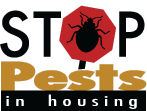-
HOME
-
» WHAT IS IPM?
-
» Definitions
Definitions
- Action Threshold
- The maximum pest population that can be tolerated at a particular time and place without posing a hazard to people, property, and the environment.
- AMP
- Asset Management Project: a grouping of various buildings into an operating entity. Each AMP has one property manager and usually has its own maintenance crew and other staff.
- Application
- The act of using a pesticide or other technique to control a pest.
- Conducive Conditions
- Attributes of a location that lead to the presence of a pest; for example, gaps under doors that allow mice to enter.
- Exclusion
- Sealing cracks or openings, or repairing damage to windows, screen doors, utility conduits, and other sites where pests can enter structures or move within structures.
- Focus Unit
- A unit with a pest infestation where the resident is hindering pest management because of poor housekeeping practices.
- Harborage
- The nesting and hiding areas of insects, rodents, and other pests. Debris and clutter often provide harborage sites.
- Hoarding
- A complex disorder comprising three connected problems: 1) collecting too many items, 2) difficulty getting rid of items, and 3) problems with organization. These problems can lead to significant amounts of clutter, which can severely limit the use of living spaces, pose safety and/or health risks, and result in significant distress and/or impairment in day-to-day living. From: http://hoarding.iocdf.org/overview.aspx
- Inspection
- A systematic search for pests, damage, stains, hair, cast skins, or other evidence to identify a pest problem and its extent.
- IPM
- Integrated Pest Management (IPM) is a decision-making process for pest control that utilizes regular monitoring to determine if and when treatments are needed, and to evaluate their effectiveness. IPM programs employ a mix of biological, cultural, mechanical/physical, educational, and least-toxic chemical strategies and tactics to keep pest numbers low enough to prevent intolerable damage or nuisance. Non-chemical methods and pest prevention are emphasized, and pesticides are used only as a last resort when other approaches prove insufficient. The goal of IPM is to achieve long-term, cost-effective, and environmentally sound pest control.
- Mechanical Controls
- Tools that can be used to control pests, such as snap traps, sticky traps, and light traps.
- Pest
- A living organism (animal, plant, or microorganism) that interferes with human purposes.
- Pesticide
- Any substance or mixture of substances intended for preventing, destroying, repelling, or mitigating any pest (U.S. EPA).
- Pest Management Professional (PMP)
- An individual employed by a company that is licensed to provide commercial pest management services.
- PHA
- Public Housing Agency or Public Housing Authority. Public housing was established to provide decent and safe rental housing for eligible low-income families, the elderly, and persons with disabilities. Public housing comes in all sizes and types, from scattered single-family houses to high-rise apartments for elderly families. The U.S. Department of Housing and Urban Development (HUD) administers federal aid to local housing agencies (HAs) that manage the housing for low-income residents at rents they can afford. HUD furnishes technical and professional assistance in planning, developing, and managing these developments. From: http://portal.hud.gov/hudportal/HUD?src=/topics/rental_assistance/phprog
- Sanitation
- Cleaning up food, water, and clutter that attract pests and allow them to survive. Another description of sanitation is “good housekeeping.”
- Section 8 Housing
- The housing choice voucher program (also known as Section 8) is the federal government's major program for helping very low-income families, the elderly, and the disabled to afford decent, safe, and sanitary housing in the private market. Since housing assistance is provided on behalf of the family or individual, participants are able to find their own housing, including single-family homes, townhouses, and apartments. Housing choice vouchers are administered locally by public housing agencies (PHAs). The PHAs receive federal funds from the U.S. Department of Housing and Urban Development (HUD) to administer the voucher program. A family that is issued a housing voucher is responsible for finding a suitable housing unit of the family's choice where the owner agrees to rent under the program. From: http://portal.hud.gov:80/hudportal/HUD?src=/program_offices/public_indian_housing/programs/hcv/about/fact_sheet
- Treatment
- Employment of procedures, application of materials, or the use of resources designed to alleviate pest problems.
